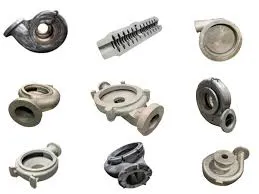Mobile:+86-311-808-126-83
Email:info@ydcastings.com
English
Understanding the Aluminum Die Casting Technique and Its Applications in Manufacturing
The Aluminum Die Casting Process An Overview
Aluminum die casting is a highly efficient manufacturing process used to produce complex shapes and components with great precision. This method is widely embraced across various industries, including automotive, aerospace, electronics, and consumer goods, due to its ability to create intricate designs that are both lightweight and strong. In this article, we will explore the aluminum die casting process, its advantages, and its applications.
What is Die Casting?
Die casting is a metal casting process that involves forcing molten metal into a mold cavity under high pressure. The molds, or dies, are typically made from durable steel and are designed to withstand the intense conditions of the casting process. The term die casting usually refers to the process involving non-ferrous metals, such as aluminum, zinc, and magnesium.
The Aluminum Die Casting Process
1. Preparation of Die The process begins with the preparation of the die. The dies are meticulously designed and machined to create the desired shape of the final product. They are usually composed of two parts the cover die and the ejector die. The surfaces of the die are treated to facilitate the easy release of cast parts.
2. Melting Aluminum Aluminum is melted in a furnace, typically at a temperature of around 660 degrees Celsius (1220 degrees Fahrenheit). This can be done through various methods, including induction melting and resistance melting. The molten aluminum must be of high quality, with minimal impurities, to ensure optimal results.
3. Injection of Molten Metal Once the aluminum reaches the desired temperature, it is injected into the die at high pressure. This pressure is crucial as it helps to fill even the most intricate parts of the mold cavity quickly, reducing the chances of defects such as air pockets or incomplete fills.
4. Cooling and Solidification After the molten aluminum has been injected, it begins to cool and solidify. The cooling time can vary depending on the thickness and complexity of the part but generally takes just a few seconds to a couple of minutes. Efficient cooling is essential, as it impacts the dimensional accuracy and surface finish of the final product.
aluminum die casting process

5. Ejection of the Cast Part Once the aluminum has fully solidified, the die halves are separated, and the cast part is ejected using ejector pins. This step must be carefully controlled to avoid damaging the newly formed part.
6. Trimming and Finishing After ejection, excess material known as flash may need to be trimmed away to achieve the final dimensions. Additional finishing processes, such as machining, polishing, or surface treatment, may also be performed to enhance the appearance and functionality of the cast component.
Advantages of Aluminum Die Casting
Aluminum die casting offers several advantages that make it a popular choice in manufacturing
- Precision and Accuracy The process allows for high dimensional accuracy and smooth surface finishes, which are crucial for intricate designs. - High Production Rate Die casting is ideal for high-volume production, as the process can be repeated quickly with minimal downtime. - Lightweight Parts Aluminum is a lightweight metal, making it suitable for industries like automotive and aerospace where weight reduction is critical. - Enhanced Strength Aluminum castings have impressive mechanical properties, providing strength and durability while being significantly lighter than steel and iron components. - Complex Geometries The versatility of die casting enables the production of complex shapes, which would be challenging to achieve with other manufacturing methods.
Applications of Aluminum Die Casting
The applications of aluminum die casting are extensive. In the automotive industry, it is used for engine components, transmission cases, and structural elements. In aerospace, aluminum die castings help in making lightweight but strong parts for aircraft. Additionally, in consumer electronics, it is utilized for housings and enclosures, contributing to both aesthetics and functionality.
In conclusion, aluminum die casting is a pivotal manufacturing process that combines efficiency with precision, enabling the production of lightweight, strong, and intricately designed components across various industries. As technology advances, the process will likely continue to evolve, offering even more innovative solutions for modern manufacturing challenges.











